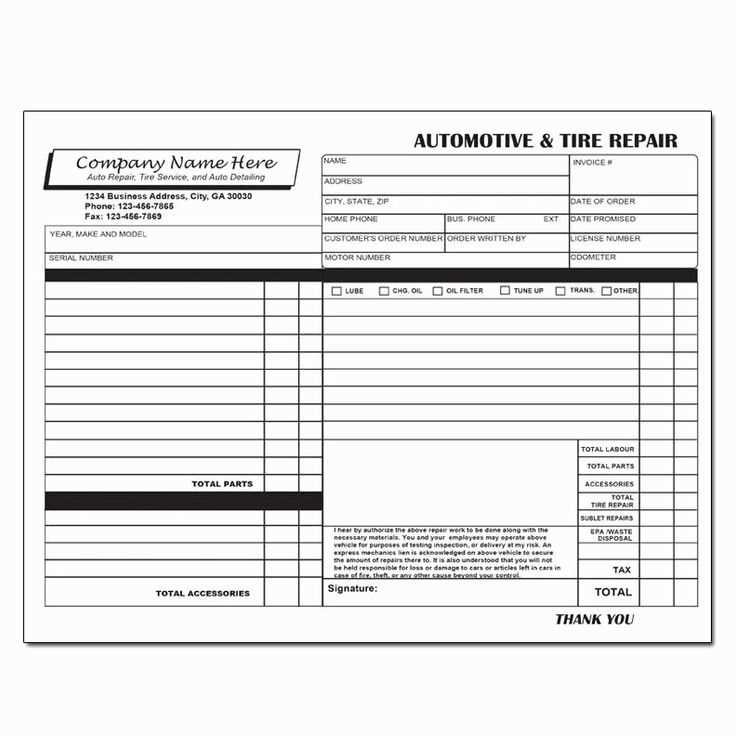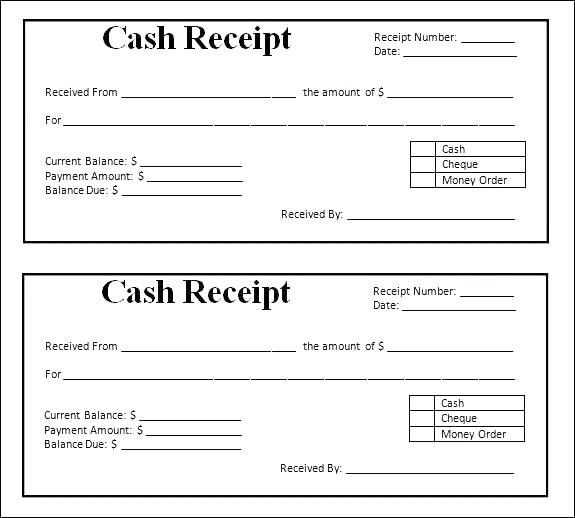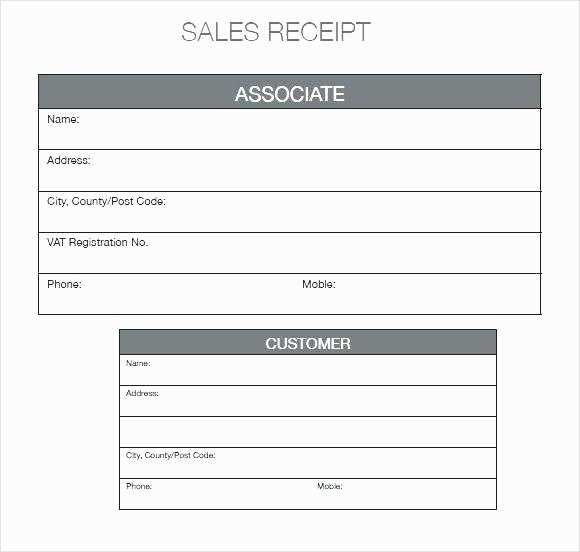
If you’re selling your car privately, it’s critical to provide a clear and accurate receipt to the buyer. A well-structured car sale receipt protects both parties, offering proof of the transaction and helping prevent any future disputes. Using a free car sale receipt template saves time and ensures you don’t miss important details that could be required later.
When creating a car sale receipt, be sure to include all relevant information: the vehicle’s make, model, year, VIN, and mileage. The buyer and seller’s names and addresses should also be listed clearly. It’s essential to specify the purchase price, along with any additional terms, such as whether the car is being sold as-is or if there are warranties. A good template will have sections to accommodate all of this.
Choosing a free template can streamline the process and give you confidence that the document is legally sound. The receipt should be signed by both parties to confirm the transfer of ownership and the agreed price. Always keep a copy of the signed receipt for your records, as it serves as proof of the transaction should any issues arise in the future.
Here’s the corrected version with minimal repetition of words:
To create a clear and professional car sale receipt, ensure all necessary details are included. First, specify the date of the transaction and full names of the buyer and seller. Mention the make, model, and year of the vehicle, along with its VIN for identification. Include the sale price and payment method used. Be sure to add any relevant warranty or “as-is” conditions if applicable.
Clearly state both parties’ agreement to the sale, and leave a space for signatures. Consider adding a statement about the transfer of ownership, which should be completed immediately upon sale. Finally, a brief note on any additional terms or conditions will help avoid future disputes.
- Free Car Sale Receipt Template
A simple and clear car sale receipt should include key details to protect both the buyer and the seller. A basic template should cover information such as the vehicle’s make, model, year, VIN, and odometer reading, along with the sale price and the date of transaction. Below is a straightforward car sale receipt template you can use for your transaction:
Template Overview:

Date of Sale: [Insert Date] Seller Information: Name: [Seller's Full Name] Address: [Seller's Address] Phone Number: [Seller's Contact Number] Buyer Information: Name: [Buyer's Full Name] Address: [Buyer's Address] Phone Number: [Buyer's Contact Number] Vehicle Information: Make: [Car Make] Model: [Car Model] Year: [Car Year] VIN (Vehicle Identification Number): [VIN Number] Odometer Reading: [Mileage] Sale Price: Amount: $[Sale Price] Payment Method: [Cash/Credit/Debit/Other] The undersigned seller affirms that the vehicle described above is sold "as-is" with no warranties against defects. Seller's Signature: ________________________ Date: ____________ Buyer's Signature: ________________________ Date: ____________
This template is designed for a straightforward transaction. Adjust it as needed to match your situation or specific state requirements. Always keep a copy for your records, and ensure both parties sign the document for verification.
Adjust your car sale receipt to fit your specific transaction. This customization ensures that the document reflects all details of the sale clearly and accurately.
Include Specific Details of the Vehicle
Start by adding the car’s make, model, year, and VIN (Vehicle Identification Number). These are key identifiers that provide clarity about the vehicle being sold. Include the car’s current mileage and any relevant condition notes, such as if the car has undergone repairs or has any damages. This helps avoid misunderstandings later on.
Define the Payment Structure
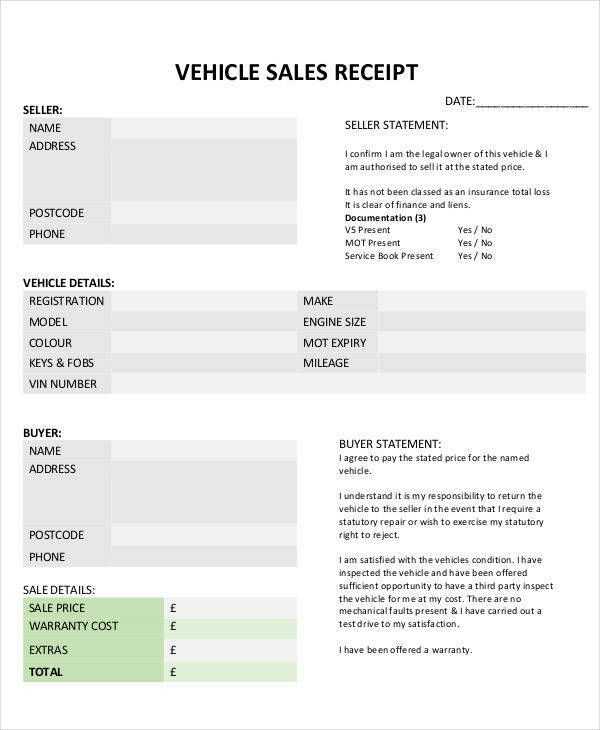
Outline the payment method used by the buyer, whether it’s a bank transfer, check, or cash. If the payment is partial, clearly state the deposit amount and balance due. You may also want to add a section for installment details if applicable, listing the amounts and due dates for future payments.
By tailoring these sections to your sale, you can avoid confusion and ensure the transaction is fully documented, protecting both parties involved.
Clearly state the buyer’s and seller’s full names, addresses, and contact details. This will help both parties verify the transaction and avoid confusion later on.
Include the date of the sale to establish the official transaction time. This is crucial for any future legal or warranty-related issues.
Provide details about the vehicle. List the make, model, year, Vehicle Identification Number (VIN), mileage, and color. These specifics make the car easily identifiable and prevent potential disputes about the car’s identity.
Clearly show the sale price and payment method. Whether it’s cash, check, or financing, this avoids misunderstandings about the amount exchanged and the payment type.
State the condition of the car at the time of sale. This can include any known defects or issues, ensuring both parties are aware of the vehicle’s status and agree on its condition.
Specify if the vehicle is sold “as-is” or with a warranty. This helps both parties understand their rights and obligations regarding repairs or refunds after the sale.
Provide a statement of the seller’s signature, along with the buyer’s, to validate the transaction. Both signatures act as confirmation that both parties agree to the terms outlined in the receipt.
For clarity and consistency, organize the date, seller, and buyer details in a structured way. Use a formal but readable format, especially since these sections hold critical legal information.
The date should be placed at the top of the document or near the title, in the format “Month Day, Year” (e.g., March 12, 2025). This is the most recognizable and clear format for both parties involved. Place it in a prominent position to avoid confusion about the sale’s official date.
For the seller and buyer information, it’s best to use a table format. This helps to separate each piece of information clearly. Here’s how to structure it:
| Party | Name | Address | Contact Information |
|---|---|---|---|
| Seller | [Seller’s Full Name] | [Seller’s Address] | [Seller’s Phone/Email] |
| Buyer | [Buyer’s Full Name] | [Buyer’s Address] | [Buyer’s Phone/Email] |
Make sure each section includes full names, addresses, and contact information (email or phone). This helps avoid future disputes and proves the identities of all parties involved.
Lastly, ensure the formatting is consistent throughout the document. Keep the text aligned and properly spaced, using clear headings for each section to improve readability and professionalism.
Accurately list the make and model of the vehicle. The make refers to the manufacturer, while the model identifies the specific series or version. For example, if you’re selling a Ford Mustang, “Ford” is the make, and “Mustang” is the model.
The Vehicle Identification Number (VIN) is a 17-character code that uniquely identifies the vehicle. Ensure you include the full VIN without omissions. This number can typically be found on the dashboard, near the windshield, or on the driver’s side door frame. It’s essential for verifying ownership and confirming vehicle history.
Include the current mileage of the vehicle, as this impacts its value. Mileage is usually displayed on the vehicle’s odometer. Make sure the reading is accurate and recent. If possible, note the exact number at the time of the sale.
Specify the payment method clearly on the receipt to avoid confusion. Detail the payment method used by the buyer, such as cash, bank transfer, or check. This ensures both parties have a record of the transaction type and can refer back to it if needed. Below are some key tips for selecting the appropriate payment method section for your receipt:
Cash Transactions
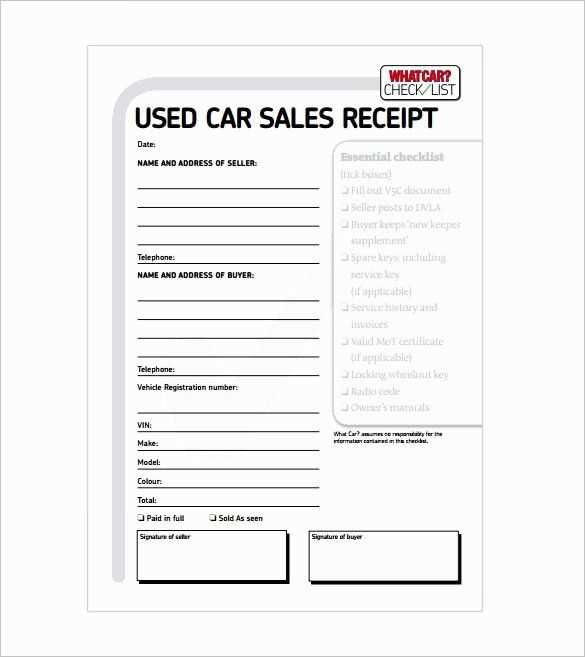
- For cash payments, record the exact amount received. Ensure you note both the payment method and the time of the transaction.
- If you provide any change, mention the exact change returned to the buyer. This helps confirm the total paid and avoids disputes.
Bank Transfer and Checks
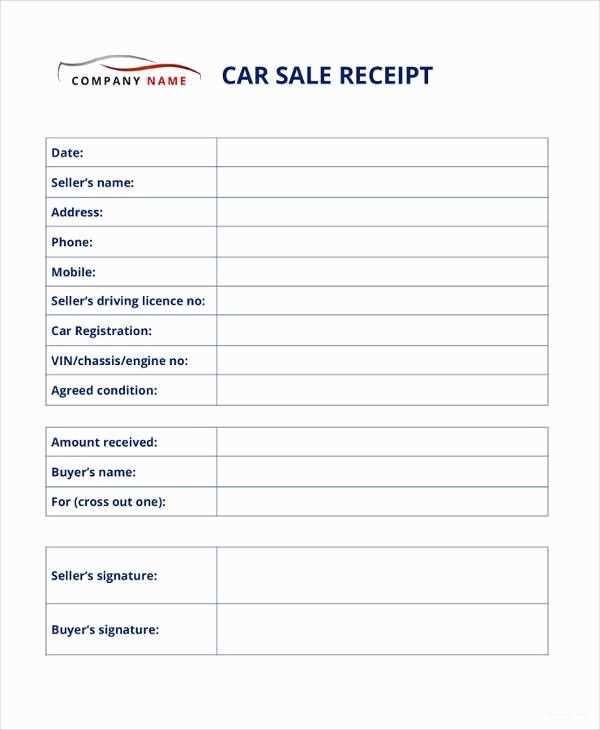
- When the payment is made through a bank transfer, include transaction details like the date and the bank reference number. This provides clarity and verifies the transfer.
- If the buyer uses a check, include the check number and the bank name. This will serve as a record in case there are any issues with the payment later.
Whatever payment method is chosen, be precise in documenting it. Clear details can resolve potential disputes and safeguard both parties involved in the sale.
Using a free template for your car sale receipt helps avoid common errors and ensures clarity in the transaction. Start by carefully filling out all required fields such as the buyer’s and seller’s information, the vehicle’s details, and the sale price. Double-check that the Vehicle Identification Number (VIN) is correct and corresponds with the car’s title. This minimizes the risk of confusion or disputes later on.
Be sure to include the date of the transaction. This prevents any ambiguity about the terms and timeline of the sale. Next, verify that both parties sign the receipt. This acts as confirmation of the agreement, helping to avoid future conflicts over the details of the sale.
Most free templates will have sections for any warranties or disclaimers, so ensure you fill those out accurately, especially if the car is sold “as is.” Omitting this information could lead to misunderstandings about the car’s condition and the buyer’s rights.
Lastly, always keep a copy of the completed receipt. Some templates allow for digital signatures or multiple copies, making it easy to store them securely. By following these steps, you’ll prevent costly mistakes and ensure a smooth transaction for both parties.
Creating a simple car sale receipt is straightforward with the right template. Below are key elements that should be included for clarity and legal purposes:
- Seller and Buyer Information: Clearly state the full names, addresses, and contact information of both parties.
- Vehicle Details: Include the make, model, year, VIN (Vehicle Identification Number), color, and odometer reading at the time of sale.
- Sale Date and Price: Specify the date of transaction and the agreed sale price. Ensure the amount is clear and detailed.
- Payment Method: Mention whether the payment was made via cash, bank transfer, check, or another method.
- Signatures: Both the seller and the buyer must sign the document to confirm the transaction is complete. Include space for both signatures.
By following these steps, you can ensure the sale is properly documented. A well-structured receipt reduces confusion and provides legal proof of transaction in case of future disputes.
